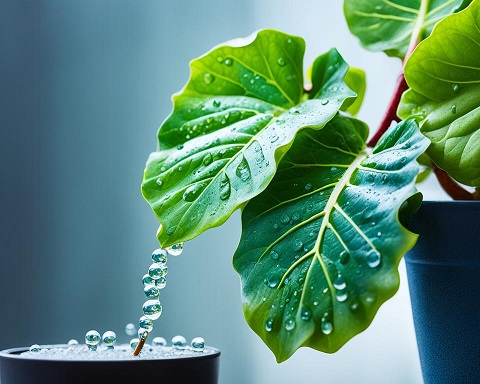
Fiddle Leaf Fig Plant Care: A Comprehensive Guide
Do you love the bold, green look of the Fiddle Leaf Fig but wonder how to care for it? This guide is here to help. I'm eager to share everything you need to know to keep these stunning plants alive at home.
The Fiddle Leaf Fig, or Ficus lyrata, is found in stylish homes around the world. It stands tall with big, eye-catching leaves. But, they need special care to flourish indoors.
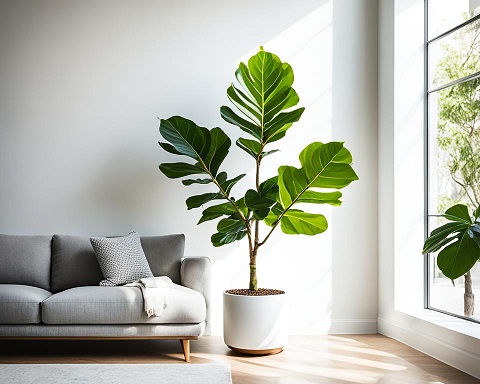
Taking care of fiddle leaf fig plants is all about being consistent. This guide will cover the best light, water, and humidity practices. We'll also talk about how to fix common problems. Let's make you a fiddle leaf fig care pro!
Key Takeaways
- Fiddle Leaf Figs need regular, careful tending to strong.
- Good light, water, and air moisture are needed for growth.
- It's important to solve problems like leaves changing color or bugs.
- Repotting and making more plants can refresh their health.
- Keeping up with a regular care plan is vital for their success.
Understanding the Fiddle Leaf Fig
The Fiddle Leaf Fig, also known as the Ficus lyrata, is a striking plant. It has large green leaves and many fans. Despite its appeal, it's challenging to care for. But, it's worth it for its beauty. It comes from the rainforests of western and central Africa. This tropical plant loves a warm, humid atmosphere. It needs a lot of water and plenty of light.
Fiddle Leaf Fig Bush vs Tree
When looking for fiddle leaf figs, you might see two types. Some look like tall, Instagram-famous trees. Others are bushier. Both forms are attractive. The tree form requires pruning to keep its shape. Notching the tree helps control where it grows. If you like it bushier, that's fine. Both styles are pretty.
Braided Fiddle Leaf Fig
Young fiddles can have their stems braided as they grow. This makes them look fuller and more bush-like. Braided fiddles are unique. They’re not as common as regular ones. But you can find them online if you look.
Do Fiddle Leaf Figs Fruit?
Yes, fiddles can fruit like other fig trees. But their fruit is not like what you usually eat. It's tasteless and filled with seeds. Fruits appear when grown outside. They're green and about the size of a golf ball.
https://www.youtube.com/watch?v=aiOdeGnTI50
Light Requirements
Fiddle Leaf Figs need a window with direct light in the morning or afternoon. The best windows are in the east, west, or south. They should not be blocked by trees or buildings. A large, unobstructed north-facing window can also do.
If your fig's near a south window, slowly let it get used to direct sunlight. Too much too fast will harm the leaves. Gradually, increase its time in the direct southern sun over 1 - 2 weeks.
Ideal Light Conditions
The more leaves a Fiddle Leaf Fig has, the more light it needs. Not enough light makes it drop lower or inside leaves. It's a clue it needs more light to keep every leaf healthy.
Assessing Your Light Levels
In winter, light gets less, which is why a plant might need to move closer to a window. But, avoid letting it get cold from any drafts. If your windows are drafty, move the plant 2 - 3 feet back and observe. This setup helps the plant stay warm and well-lit.
Using Grow Lights
When natural light is lacking, use a grow light to help your plant out.
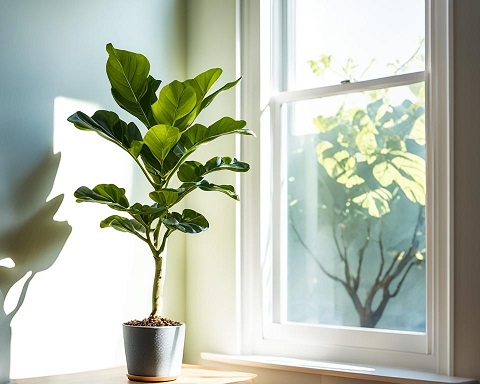
Watering Fiddle Leaf Fig Plants
People often make a big mistake by giving too much water to their fiddle leaf figs. You can tell they're overwatered if you water them more than once a week. Also, check for wet soil up to one inch deep and dark spots on the leaves. If you see flies or smell something musty from the soil, these are also signs of too much water. Remember, if you overwater, your plant might get root rot.
If your fiddle leaf fig doesn't get enough water, you'll see some different signs. These signs include new leaves that are smaller than the older ones, leaves falling off, and very dry soil on top. You might also notice brown edges on the leaves. But, too little water is not good either. It can make the leaves change color and drop. So, it's key to find the right balance.
How Often to Water Fiddle Leaf Fig
Finding the right watering schedule is important for fiddle leaf figs. A good guide is to water your plant the same amount every week. For a plant less than 2 feet, give it 1 cup a week. If it's over 2 feet, you'll need 2 cups weekly. Taller plants from 3 to 6 feet require 3 cups. And those over 6 feet, use 4 cups every week until the water drains from the pot. But, be careful not to water too often. Let the soil dry a bit between waterings to prevent overwatering.
Fiddle Leaf Fig Plant Care
Caring for a fiddle leaf fig involves a few key steps. Firstly, dust the leaves often to keep them clean. This helps the plant get more sunlight and make food. Next, turn the plant every 1-2 weeks. This makes sure all sides get enough light and growth stays even. Prune the plant to make it grow more branches and keep it a good size. Also, loosen the soil every now and then to keep it healthy. Don't forget to add slow-release fertilizer in spring and summer. This feeds the plant slowly over time. By following these steps regularly, your fiddle leaf fig will do well.
Humidity and Temperature
Fiddle Leaf Figs are tropical plants and love humidity. If it's too dry around them, they'll lose their leaves. It's good to keep them inside air conditioned places, but not close to vents. These plants do better with a fiddle leaf fig humidity that's just right, which you can achieve using a humidifier.
These plants like it warm, between 65-85°F. Cold drafts or freezing temps make them unhappy. In winter, keep your fiddle leaf fig away from cold windows and drafts. It's important to keep the fiddle leaf fig temperature just right for it to be happy and grow well.

Soil and Fertilizer
Fiddle Leaf Figs grow best in a well-draining mix. Don't use heavy soils that hold too much water. Pick a light potting mix for houseplants. You can add perlite or orchid bark for better drainage. Also, ensure the pot has holes at the bottom.
Choosing the Right Potting Mix
Choose a quality, well-draining soil for your fiddle leaf fig. Opt for indoor plant mixes or potting soil. Include perlite or orchid bark in the mix. This keeps the soil loose and prevents overwatering. Compact soil can harm the roots.
Fertilizing Schedule
Fiddle Leaf Figs like to be fed during spring and summer. Use a balanced, water-soluble or slow-release fiddle leaf fig fertilizer. Apply it once a month. Be careful not to use too much fertilizer. A little food goes a long way for fiddle leaf fig plants.
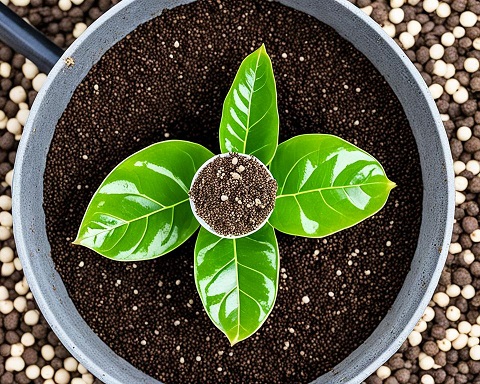
Pruning and Maintenance
Pruning helps keep fiddle leaf fig plants looking good. They normally grow straight up. But, with pruning, they can get bushier and stay the size you want. Do this in the spring or early summer, when the plants are growing.
When to Prune
To prune a fiddle leaf fig, grab clean, sharp scissors. Cut just above a leaf node or next to a branch. Keep the main stem untouched. By cutting the bottom leaves, your tree will form a nice lollipop shape. Remember to throw away the leaves you cut off. They might spread disease if you leave them around.
Pruning Techniques
Keeping the leaves clean is key for fiddle leaf fig care. The big leaves can get dusty, stopping the plant from getting enough sun. Use a damp cloth to gently clean the leaves every now and then. This makes sure your plant stays healthy.
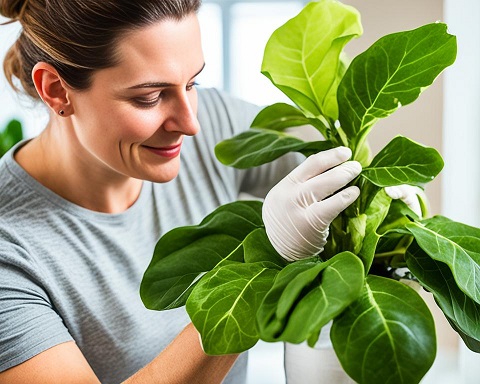
Troubleshooting Common Issues
If your fiddle leaf fig's leaves turn brown or get spots, that's a sign of problems. Overwatering, poor light, or pests might be the cause. Watch your plant closely and adjust care to fix leaf issues.
Leaf Discoloration and Dropping
Fiddle leaf figs can get pests like spider mites or mealybugs. Check your plant often. Use insecticidal soap to treat pests. Good care helps keep pests away.
Pest Management
Root rot and fungal diseases can happen if your plant is too wet. Signs are leaves wilting or turning yellow. If you see these signs, check the roots. Repot in dry soil if necessary.
Always care for your plant properly to avoid diseases.
Root Rot and Diseases
Fixing leaf troubles and managing pests helps your fig plant stay healthy. Follow these tips for a happy, green fiddle leaf fig.
Repotting and Propagation
Your fiddle leaf fig's size will increase with time. It needs to be moved to a bigger pot every 18-24 months. This helps it keep growing well. You'll know it's time to repot when roots start showing through the bottom of the pot. Also, if the soil dries fast or the plant seems too small for its pot, it needs a new home.
Signs Your Fiddle Needs Repotting
If you see the signs it needs repotting, do it in spring or summer. This is when the plant grows the most. By repotting at the right time, you help the plant adjust better. It won't get too stressed by the change.
How to Repot a Fiddle Leaf Fig
Get a new pot that's a bit bigger, about 2-4 inches wider around. Carefully take the plant out of its current pot. Be gentle with the roots, not to hurt them. Cut any roots that look bad, then plant your fig in fresh soil.
After you're done, water the plant well. It might lose a few leaves for a bit, but that's normal as it gets used to its new space.
Propagating Fiddle Leaf Figs
If you want more plants, you can also grow them from cuttings. Cut a piece that's 6-8 inches, just under a leaf. Take off the bottom leaves. Put the cutting in water or soil and keep it damp. When it roots, put it in its own pot. With good care, your new fig plant will grow strong.
Conclusion
Taking care of a fiddle leaf fig plant means being consistent and paying attention to details. But, seeing these amazing plants grow in your home makes it all worth it. You just need to give them the right light, water, and care.
This care routine might be a bit of a challenge but the results are worth it. A thriving fiddle leaf fig adds beauty to any room. To keep it happy, watch its light and water needs closely. It will take some patience, but your fiddle leaf fig will bring you happiness for a long time.
Consistency is key to looking after a fiddle leaf fig properly. Stick to your care routine and stay focused on what your plant needs. This way, your fiddle leaf fig will stay healthy and bring joy to your home as it grows.
FAQ
What is a Fiddle Leaf Fig?
The Fiddle Leaf Fig is a beautiful plant with big green leaves. It's popular with many people. This plant comes from the rainforests of Africa.
What is the difference between a Fiddle Leaf Fig Bush and Tree?
These plants don't look like lollipops naturally. They are pruned to have that shape. A bushy look is also nice for indoor settings.
Can Fiddle Leaf Figs be Braided?
Yes, you can braid young Fiddle Leaf Figs when their stems are still soft. This makes them look fuller and adds a lovely design to the trunk.
Do Fiddle Leaf Figs Produce Fruit?
Since they are fig trees, they can have fig-like fruits. But, the fruits are usually tasteless and indoor plants rarely get them.
What are the Ideal Light Conditions for a Fiddle Leaf Fig?
These plants need a lot of light. A spot with direct sun from an eastern, western, or southern window is good. A north window can work too if it's very bright there.
How Can I Assess the Light Levels for My Fiddle Leaf Fig?
If your plant's lower leaves are falling off, it might not be getting enough light. More leaves mean your plant needs more light to stay healthy.
When Should I Use a Grow Light for My Fiddle Leaf Fig?
Use a grow light in winter when there's less natural light. It will help your plant keep thriving.
How Often Should I Water My Fiddle Leaf Fig?
Water your plant the same amount each week. Smaller plants need about a cup of water. Larger plants can use up to four cups. Let the soil dry a bit between waterings.
What are the Signs of Overwatering or Underwatering a Fiddle Leaf Fig?
Overwatering can cause wet soil and dark spots on leaves. Underwatering leads to tiny leaves and dried-up soil. Both can make leaves fall off.
What is the Ideal Humidity and Temperature Range for a Fiddle Leaf Fig?
These plants like humidity and warmth. Keep the room between 65-85°F. Avoid direct air from heaters or AC, which makes the air too dry.
What Type of Potting Mix is Best for a Fiddle Leaf Fig?
Use a potting mix that drains well. Heavy, soggy soil is bad for these plants.
How Often Should I Fertilize My Fiddle Leaf Fig?
Feed your plant every month in spring and summer. Use a fertilizer made for houseplants. This will help it grow strong and healthy.
When is the Best Time to Prune a Fiddle Leaf Fig?
Prune in spring or early summer when the plant grows most. This keeps it in good shape and size.
How Do I Clean the Leaves of My Fiddle Leaf Fig?
Dust off the leaves regularly. Clean them gently with a damp cloth every few months. This keeps the plant healthy.
What are Some Common Issues with Fiddle Leaf Fig Leaves?
Leaf problems signal water, light, or pest issues. Watch your plant closely and adjust as needed.
What Pests and Diseases Can Affect Fiddle Leaf Figs?
Look out for spider mites, scale, and mealybugs. These plants can also get sick from too much water, like root rot.
How Often Should I Repot My Fiddle Leaf Fig?
Repot every 18-24 months for healthy growth. Signs you need to repot include roots showing, very fast drying soil, or a stunted plant.
Can I Propagate a Fiddle Leaf Fig?
Yes, you can make new plants from cuttings. Pick a 6-8 inch cutting, remove some leaves, and place it in water or soil until it roots.



